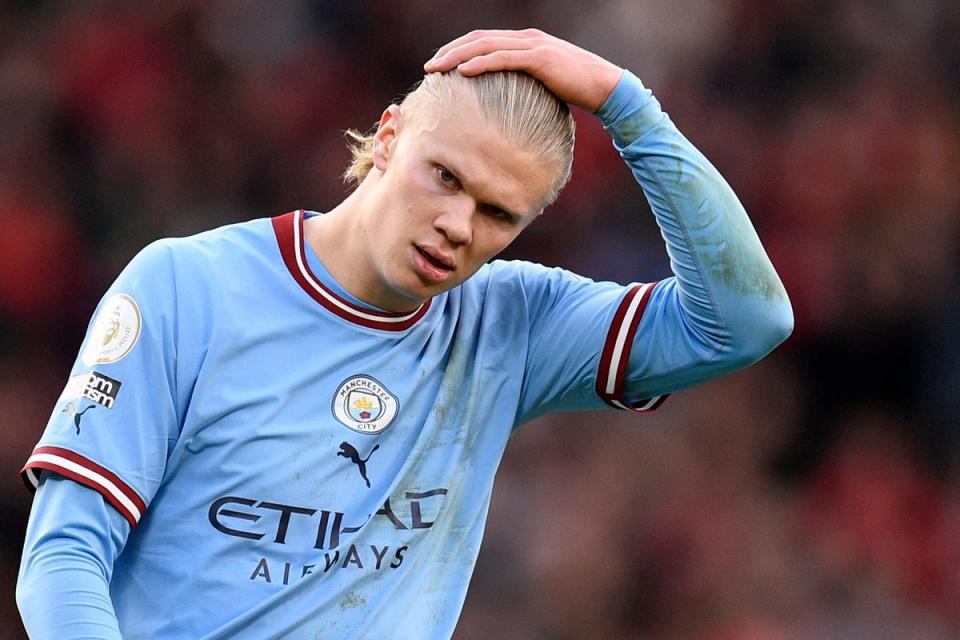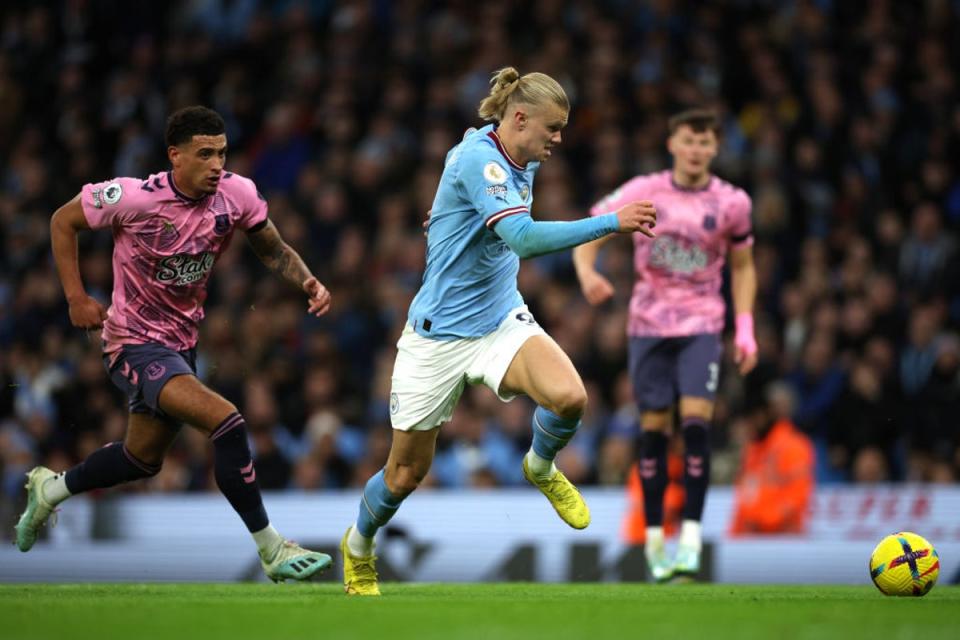How does Pep Guardiola make the numbers add up for Man City and Erling Haaland?

At a fraught point in the Manchester derby, Pep Guardiola felt he had to get something off his mind. The Catalan called Erling Haaland over and intensively gave the Manchester City forward a series of instructions.
As he listened, the Norwegian didn’t look anywhere near as enthused about any of this as his manager. Haaland stood there with his hands on his shoulders. That might have been down to his generally impassive appearance, but it came as part of a very passive performance.
Haaland was barely involved, with only 19 touches, and two shots. Even Jack Grealish beat him to a header for a goal that could have been his, effectively removing the forward from what he is supposed to be there for.
Those last few words nevertheless provoke a far bigger question, that is complicating City’s season. Is Haaland there for goals, or more?
He clearly wasn’t doing what Guardiola wanted - and that doesn’t just apply to this 2-1 defeat to Manchester United. The City manager outright admitted that he wants the Norwegian more involved in play.
“Yes,” Guardiola said when directly asked. “At the moment, we have that process because when teams are sat in their 18-yard box it is more difficult but we have to find him a little bit more, yes.
“Today he had enough touches but it’s true that when you are looking at areas and you have to look at him - but we will do it.”
Those last four words were effectively an admission that there is a problem to solve. It is one with a lot of positives, of course, since Haaland offers so many goals. Those goals nevertheless come at some cost to the team.
This isn’t a new problem, either. It is something Guardiola has faced before with Zlatan Ibrahimovic and Manchester United have just come through with Cristiano Ronaldo. It isn’t exactly the same as those, obviously, but it is something of an extreme given the extremes that both manager and player themselves represent.
Haaland has already scored 21 goals before the halfway mark of the campaign and it is reasonable to think he could be the first player to hit 40 in an English top-flight season since Jimmy Greaves in 1960/61.
That comes from a minimalism that had previously been praised as a virtue, and an average of 26.8 touches per 90 minutes. Haaland barely needed to be on the ball to score.
Erling Haaland’s touches per Premier League game
Opponents | Touches | Minutes | Goals |
|---|---|---|---|
West Ham | 32 | 78 | 2 |
Bournemouth | 8 | 74 | 0 |
Newcastle | 33 | 90 | 1 |
Crystal Palace | 16 | 84 | 3 |
Nottingham Forest | 16 | 69 | 3 |
Aston Villa | 27 | 90 | 1 |
Wolves | 24 | 90 | 1 |
Man United | 35 | 90 | 3 |
Southampton | 28 | 90 | 1 |
Liverpool | 39 | 90 | 0 |
Brighton | 33 | 80 | 2 |
Fulham (sub) | 11 | 26 | 1 |
Brentford | 21 | 90 | 0 |
Leeds | 27 | 90 | 2 |
Everton | 18 | 90 | 1 |
Chelsea | 31 | 90 | 0 |
Man United | 19 | 90 | 0 |
It was always obvious this was going to represent an issue for Guardiola at some point, though, and it had admittedly been raised before the season began only to be drowned out by so many goal celebrations.
The City manager’s football has in many ways been the opposite of minimalism, given it has always been about maximising the ball by taking complete control of it. This was best illustrated by record possession statistics in the first few years of his coaching career, with the purpose of that being to overwhelm opposition sides with so many overloads.
The grand realisation of this was probably Barcelona’s 2011 Champions League final, also against Manchester United. That 3-1 victory at Wembley could even be described as Guardiola’s signature performance.
In that match, the starting outfield player with the fewest touches was David Villa, with 41 over 86 minutes. The average for the first XI was 87.5.
Touches for Guardiola’s starting XI in 2011 Champions League final
Victor Valdes, 33 (90 minutes)
Dani Alves, 81 (88)
Javier Mascherano, 74 (90)
Gerard Pique, 63 (90)
Eric Abidal, 58 (90)
Sergio Busquets, 97 (90)
Xavi, 156 (90)
Andres Iniesta, 127 (90)
Pedro, 53 (90)
Lionel Messi, 125 (90)
David Villa, 41 (86)
Guardiola’s football has naturally evolved since then, and incorporated more direct transitions, but there have been constants.
The signature display of his second cycle at City - that developed since the David Silva-Vincent Kompany core moved on - was probably another game against Manchester United, in this corresponding fixture last season. That was a 2-0 win that felt like it could have been 5-0. City flawlessly passed United off the pitch.
The average number of touches for the starting XI that day was 95. False nine Bernardo Silva had 86 touches. Gabriel Jesus, who Haaland has effectively replaced, had 73. If that was itself an extreme due to the nature of that match and how City toyed with United, Jesus’ average touches for the club never dropped below 38 per 90 in any of his seasons. He was much more involved in play, as can be seen now with Arsenal.
Touches for Guardiola’s starting XI in 2-0 win over Manchester United, November 2021
Touches for Guardiola’s starting XI vs Manchester United, November 2021
Ederson, 27 (90 minutes)
Kyle Walker, 122 (90)
John Stones, 72 (90)
Ruben Dias, 91 (90)
Joao Cancelo, 125 (90)
Kevin De Bruyne, 113 (90)
Rodri, 115 (90)
Ilkay Gundogan, 71 (90)
Gabriel Jesus, 73 (90)
Bernardo Silva, 86 (90)
Phil Foden, 82 (90)
Haaland’s touches against United this time around represent half of that lowest average, and far less than Jesus in the same fixture last season.
The wider point to all of this, and the problem to figure out for Guardiola, is that it means he isn’t implementing his ideal with a full team. City are essentially constructing play with 10 men. It almost comes down to the maths, which is ironic given the numbers. It’s a lot more difficult to overload and overwhelm when one player is always missing from this play; when you have one less passing option in so many areas. A Guardiola team just can’t create the same angles or shapes.
This obviously isn’t to discount Haaland’s benefit to a collective beyond his goals. His very presence shapes games. His movement means defenders have to be alert. That opens space for teammates to play through.

It still isn’t the same as another player showing to take the ball, to offer the option of an overload. Haaland in essence stretches Guardiola’s ideal rather than fitting into it. This is how gaps appear, why team moves are not as potent and how more passes go astray - as repeatedly happened at Old Trafford.
United were then able to exploit those gaps with their transitions and breaks, as Guardiola so conspicuously referenced.
The Catalan stated how he is well used to the “history” of their “transitions”, but not even Sir Alex Ferguson’s side hurt him like that. There weren’t as many breakdowns in possession.
City’s passing success in that game was 92%. Here, it was 89%.
The difference brought this game down to wider margins, which made City more susceptible to United’s breaks and that contentious Bruno Fernandes goal.
Now, the margin that matters most to City’s season may not be the points gap to Arsenal. It might be that between the effect of Haaland’s goals and the effect on the team’s coherence.
This wasn’t unforeseen, but the extent of it was perhaps unexpected. If anyone can figure it out, it’s Guardiola. Haaland is too potent. There’s still the constant danger of De Bruyne supplying the Norwegian with through balls. They often happen before defenders have time to think.
For the moment, however, Guardiola has something more immediate than Arsenal’s lead to occupy his mind.

